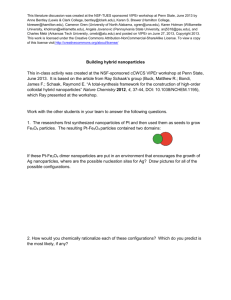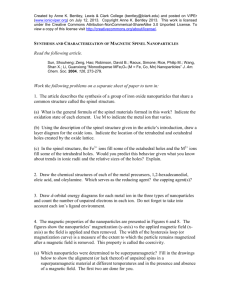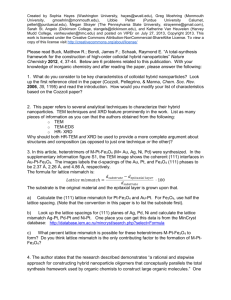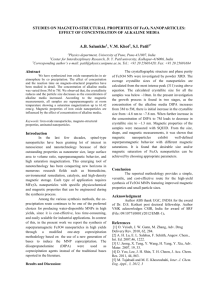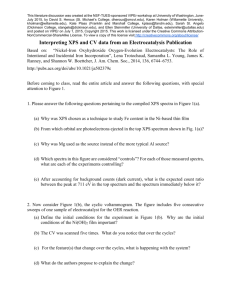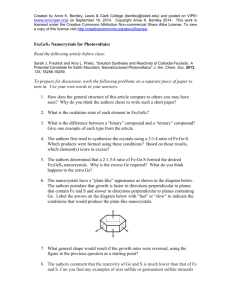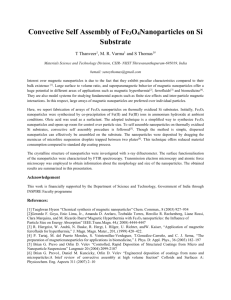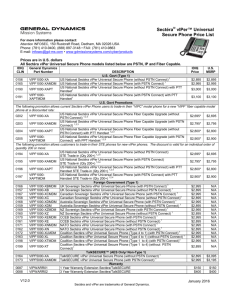LitLOSchaak1
advertisement
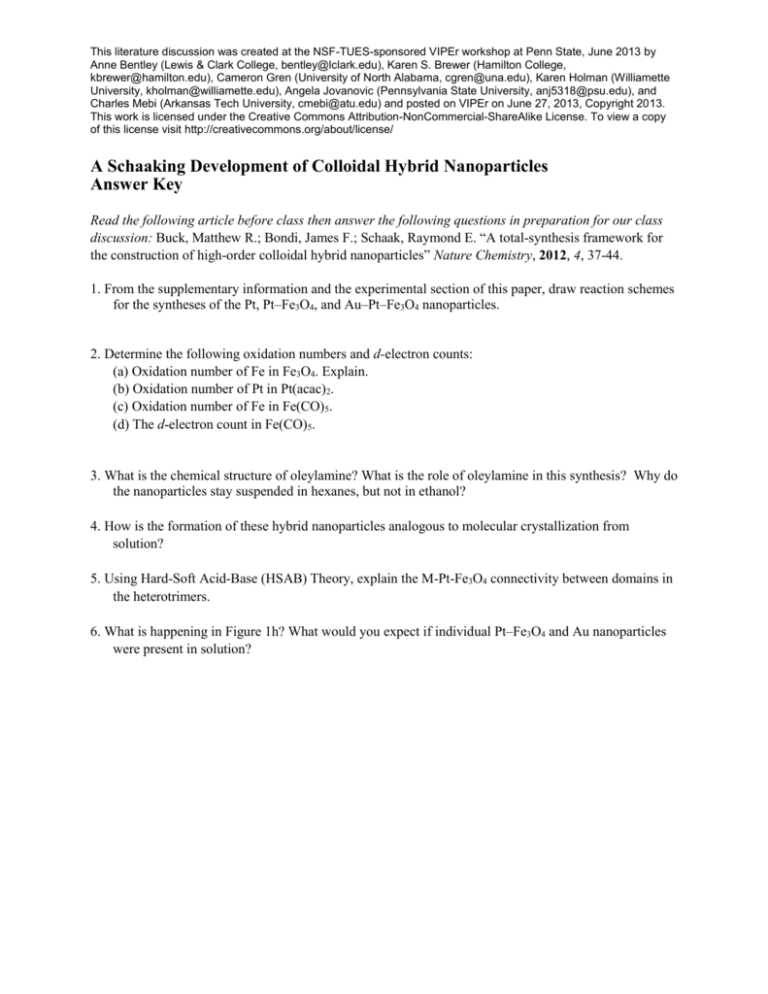
This literature discussion was created at the NSF-TUES-sponsored VIPEr workshop at Penn State, June 2013 by Anne Bentley (Lewis & Clark College, bentley@lclark.edu), Karen S. Brewer (Hamilton College, kbrewer@hamilton.edu), Cameron Gren (University of North Alabama, cgren@una.edu), Karen Holman (Williamette University, kholman@williamette.edu), Angela Jovanovic (Pennsylvania State University, anj5318@psu.edu), and Charles Mebi (Arkansas Tech University, cmebi@atu.edu) and posted on VIPEr on June 27, 2013, Copyright 2013. This work is licensed under the Creative Commons Attribution-NonCommercial-ShareAlike License. To view a copy of this license visit http://creativecommons.org/about/license/ A Schaaking Development of Colloidal Hybrid Nanoparticles Answer Key Read the following article before class then answer the following questions in preparation for our class discussion: Buck, Matthew R.; Bondi, James F.; Schaak, Raymond E. “A total-synthesis framework for the construction of high-order colloidal hybrid nanoparticles” Nature Chemistry, 2012, 4, 37-44. 1. From the supplementary information and the experimental section of this paper, draw reaction schemes for the syntheses of the Pt, Pt–Fe3O4, and Au–Pt–Fe3O4 nanoparticles. 2. Determine the following oxidation numbers and d-electron counts: (a) Oxidation number of Fe in Fe3O4. Explain. (b) Oxidation number of Pt in Pt(acac)2. (c) Oxidation number of Fe in Fe(CO)5. (d) The d-electron count in Fe(CO)5. 3. What is the chemical structure of oleylamine? What is the role of oleylamine in this synthesis? Why do the nanoparticles stay suspended in hexanes, but not in ethanol? 4. How is the formation of these hybrid nanoparticles analogous to molecular crystallization from solution? 5. Using Hard-Soft Acid-Base (HSAB) Theory, explain the M-Pt-Fe3O4 connectivity between domains in the heterotrimers. 6. What is happening in Figure 1h? What would you expect if individual Pt–Fe3O4 and Au nanoparticles were present in solution? This literature discussion was created at the NSF-TUES-sponsored VIPEr workshop at Penn State, June 2013 by Anne Bentley (Lewis & Clark College, bentley@lclark.edu), Karen S. Brewer (Hamilton College, kbrewer@hamilton.edu), Cameron Gren (University of North Alabama, cgren@una.edu), Karen Holman (Williamette University, kholman@williamette.edu), Angela Jovanovic (Pennsylvania State University, anj5318@psu.edu), and Charles Mebi (Arkansas Tech University, cmebi@atu.edu) and posted on VIPEr on June 27, 2013, Copyright 2013. This work is licensed under the Creative Commons Attribution-NonCommercial-ShareAlike License. To view a copy of this license visit http://creativecommons.org/about/license/ 7. The authors used a wide range of techniques to characterize the heterostructures. (a) In the table below, use a check mark to identify the technique(s) used to provide the type of information specified. More than one technique may answer each question, and individual techniques may answer more than one question. Which technique provided information about... TEM EDS XRD SAED XPS UV-vis STEM / element mapping ...the presence or absence of an element? ...the crystal structure of the phases present? …the size of a nanoparticle? …an element’s chemical environment? ...the spatial location of elements? (b) Explain why the authors could not rely on TEM alone to characterize the heterostructures. 8. The pure metals used in this work (Au, Ag, Pt, Pd, and Ni) have atoms packed in the face-centered cubic structure. Magnetite (Fe3O4) forms the spinel structure in which metal ions fill holes in an fcc lattice of oxide ions. (a) Draw a layer diagram for the fcc structure. (b) Sketch a (111) plane on the cubic unit cell shown below. This literature discussion was created at the NSF-TUES-sponsored VIPEr workshop at Penn State, June 2013 by Anne Bentley (Lewis & Clark College, bentley@lclark.edu), Karen S. Brewer (Hamilton College, kbrewer@hamilton.edu), Cameron Gren (University of North Alabama, cgren@una.edu), Karen Holman (Williamette University, kholman@williamette.edu), Angela Jovanovic (Pennsylvania State University, anj5318@psu.edu), and Charles Mebi (Arkansas Tech University, cmebi@atu.edu) and posted on VIPEr on June 27, 2013, Copyright 2013. This work is licensed under the Creative Commons Attribution-NonCommercial-ShareAlike License. To view a copy of this license visit http://creativecommons.org/about/license/ (c) Figure 2a shows X-ray diffraction data for each of the heterotrimers. Use the Bragg equation (assume n = 1) and the d-spacings reported in the article to identify the (111) peak for each material. The Bragg equation is 𝑛λ=2dsinθ The Cu K radiation has a wavelength of 1.54 A. metal d111(angstroms) peak position (2) Ni Pt Au Ag Fe3O4 (d) Do the peak positions follow the trend you would expect based on the d-spacings of each material? Explain. (e) Which metal in Figure 2a is missing from the article’s discussion of d-spacing and the table above? Why? 9. What do the authors suggest that we can learn from the UV-Vis spectra presented in Figure 2d? Why is this finding important? 10. Consider Figure 3e. How does the binding energy of Pt change when it is bound to Fe3O4? What does the shift indicate about the electron density of Pt in Pt-Fe3O4 vs. Pt nanoseeds? How does this explain why the Au selectively binds to the Pt? 11. (a) Considering the three domains that exist for the Ag-Pt-Fe3O4 trimer, describe how this system is analogous to concepts of regio- and chemoselectivity in synthetic organic chemistry, identifying the roles of each of the three domains. Back up with specific examples from the paper. (b) Why is this work particularly important to the field of nanoscience? 12. Look up one of the articles cited (refs 4-12) which describe applications of colloidal hybrid nanoparticles. Come to class prepared to describe the significance of this work in that context.
